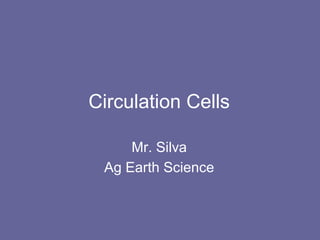
6.3 circulation cells
- 1. Circulation Cells Mr. Silva Ag Earth Science
- 2. Air Circulation Cells Preview 2
- 3. Hadley Air Circulation Cells • Circulation of hot air near the equator • Air is heated, rises and spreads north and south toward subtropics. • Subtropic air replaces hot tropical air...process starts again 3
- 4. Hadley Air Circulation Cells • high humidity • high clouds • heavy rains/precipitation • No winter!!! • Temperature change greater from day to night than from season to season. 4
- 5. Ferrel Air Circulation Cells • Ferrel cells develop between 30* and 60* north and south latitudes. • Great seasonal fluctuation of temperature. 5
- 6. Ferrel Air Circulation Cells • Distinct winter season • Usually has broadleaf deciduous and evergreen coniferous forest 6
- 7. Polar Air Circulation Cells • Icy-cold, dry, dense air descends from the troposphere • Meets warmer air at mid latitudes and then returns to the poles cooling and sinking • Sinking air suppresses precipitation, thus polar regions are deserts 7
- 8. Polar Air Circulation Cells • Low temperatures • severe winters • small amounts of precipitation • Two biomes: – tundra – taiga 8
- 9. Air Circulation Cells Review 9
- 10. Hurricanes, Cyclones, and Tornadoes, Oh My! • Hurricanes are the most severe weather phenomenon on the planet...cyclonic circulation of air, thunderstorms, and rain • Tornadoes are swirling masses of air with wind speeds of 300mph that happen over land. • Cyclones are larger than tornadoes, happen over water and last several days. 10
- 11. Tornadoes 11
- 12. Hadley Air Circulation Cells • Circulation of hot air near the equator • Air is heated, rises and spreads north and south toward subtropics. • Subtropic air replaces hot tropical air...process starts again • Hadley cells characterized by high humidity, high clouds, and heavy rains • No winter!!! Temperature change greater from day to night than from season to12 season.
- 13. Coriolis Effect • Uneven heating of the Earth’s surface – caused by the Earth’s axis, rotation, and revolution around the sun. 13